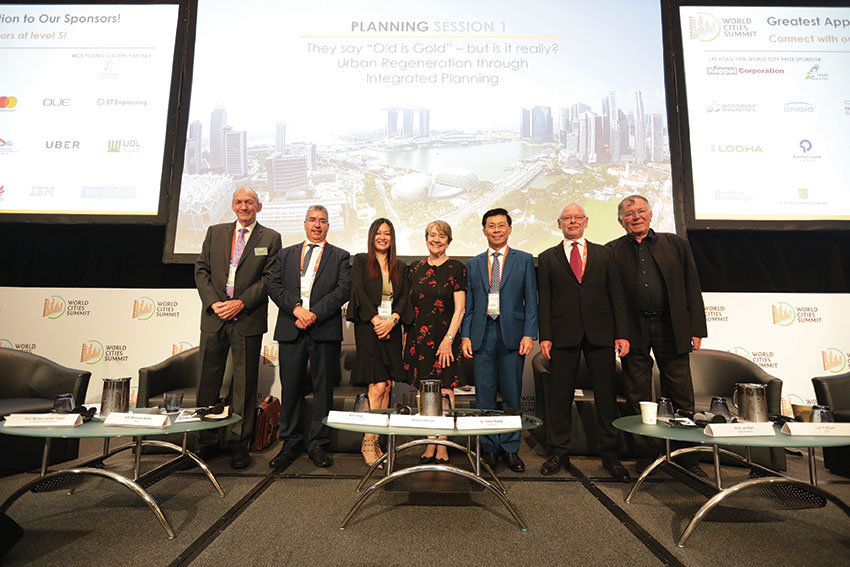Sep - Oct 2018
World Cities Summit: Special Report
October 28, 2018
by Carissa Kwok

“Old is Gold” — but is it really?
The various urban systems in cities need to be coordinated through an integrated urban plan to create liveable outcomes, and to sustain quality of life for its citizens. Integrating social, economic and environmental considerations into planning efforts is required to rejuvenate distressed urban areas in a holistic manner. This thematic track session discussed how can the use of innovative technology and systems help governments make more informed planning decisions.
Moderated by Prof Marilyn Taylor (Architecture and Urban Design, University of Pennsylvania), this session’s speakers include H.E. Mohamed Sadiki (Mayor, Rabat); Nina Yang (CEO, Sustainable Urban Development, Ascendas-Singbridge); Nicholas Brooke (Chairman, Hong Kong Harbourfront Commission, and Trustee, Urban Land Institute); Dr Gábor Bagdy (Deputy Mayor, Budapest); Prof Jan Gehl (Founder, Gehl Architects); and Lee Yi Shyan (Chairman of Board of Directors of REIT Managers, OUE).
Yang observed that since two-thirds of the global population growth will be in urban areas, the idea of creating new urban centres is not a feasible one as this will consume valuable arable land, put pressure on existing infrastructure, and compete for limited government fund. She emphasised the need to recognise the multi-faceted requirements of urban growth, with the consideration of rejuvenation and intensification.
Prof Gehl shared that one strategy for liveable, healthy cities is by putting people first in city planning; modernism and motorism should not be the motto. He cited a case where 41 per cent of citizens in Copenhagen commuted via bicycle in 2017, a notable culture.
Prof Taylor concluded the session with the following, “We need to not just throw out terms like integrated planning and more infrastructure. We need to focus our efforts, as Prof Gehl has said, on changing the mindset one step at a time, one project at a time, balancing large-scale and small, so that we are buildingthe people-oriented places that everyone would feel welcome to live in.”
Social resilience – A critical component of a liveable and sustainable city?
Urban resilience is about the capacity of individuals, communities, institutions, businesses and systems within a city to adapt and thrive despite stresses and acute shocks. Cities are becoming more connected digitally, yet there are increasing cultural differences, rising socio-economic disparities and aging infrastructure. By harnessing technology and social networks, dense urban populations provide many opportunities for creating connections and social support. Often, the appropriate social networks and capital are both the first and last line of defence in times of crisis, be it terrorist attacks, financial crisis or natural disasters. This thematic track session touched on how we can cultivate and build up the social resilience of cities.
Moderated by Michael Berkowitz (President, 100 Resilient Cities), this Berkowitz opened the session with the following, “Social resilience is the x-factor. We can build infrastructure to account for what we want to design for, be it climate change, earthquakes, typhoons or heatwaves—we can build the infrastructure; we have the know-how. But the next thing that happens will not be that earthquake or hurricane or tornado or even terrorism, it’s going to be something else. And social resilience—cohesive communities where neighbours check on neighbours; where we not just take care of the elderly, but also use their strength, knowledge and grounding; where we have strong neighbourhood institutions and small businesses—all of those things, we now know, are the ones that differentiate between a more fragile city and a more resilent one.”
Mayor Veliaj shared, “We calculated that the average family spend 30 per cent of their income raising the car (between the purchase of the car, parking, insurance, etc.). Twenty per cent went to the child; meaning for food, clothing, education, etc. So are we building cities for people or for cars? I think that there are plenty of ways that data can be used for policymakers; not only to change decisions, but also to confront people’s values.”
Portas elaborated, “If you have a different department that is involved in education, and a different one that is involved in health, how do you get those various departments to work together, to collaborate, to integrate? That is the issue. That is really tough to do at a national level.”
The next World Cities Summit will be held from 5 to 9 July 2020 at the Sands Expo and Convention Centre, Marina Bay Sands, Singapore. The World Cities Summit Mayors Forum 2019 will be held in Medellín, Colombia, from 10 to 12 July.
For more information, please visit https://www.worldcitiessummit.com.sg/.
To read the complete article, get your hardcopy at our online shop/newsstands/major bookstores; subscribe to FuturArc or download the FuturArc App to read the issues!
Previously Published Happening
Contact us at https://www.futurarc.com/contact-us for older articles.

